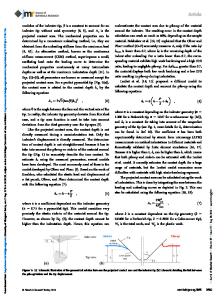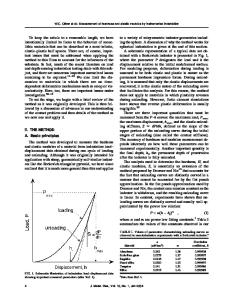Continuous electrical in situ contact area measurement during instrumented indentation
- PDF / 317,983 Bytes
- 6 Pages / 612 x 792 pts (letter) Page_size
- 15 Downloads / 453 Views
Christopher L. Muhlstein,a) James G. Collins, and Amber L. Romasco Department of Materials Science and Engineering, The Pennsylvania State University, University Park, Pennsylvania 16802
Lawrence H. Friedman Department of Engineering Science and Mechanics, The Pennsylvania State University, University Park, Pennsylvania 16802 (Received 25 January 2008; accepted 4 June 2008)
The primary tool for mechanical characterization of surfaces and films is instrumented indentation using the Oliver-Pharr data analysis method. However, this method measures contact area between the indenter and sample indirectly, thus confounding instrumented indentation tests when characterizing dynamic properties, thin films, and materials that “pileup” around the indenter. Here, we demonstrate an electrical technique to continuously measure the in situ contact area by relating nonlinear electrical contact current–voltage (I–V) curves to the instantaneous contact area. Using this approach, we can obtain hardness as a continuous function of applied force.
I. INTRODUCTION
Mechanical characterization of films and surfaces is an invaluable tool for ongoing research in a broad range of fields including protective coatings, electronic devices, and functionalized surfaces.1–4 In a relatively short period of time, instrumented indentation (e.g., nanoindentation) has emerged as a dominant method that is used as frequently as traditional tensile testing—if not more often. With instrumented indentation, the contact areas between the indenter and sample are inferred from force– displacement curves (Fig. 2, inset) via the celebrated Oliver-Pharr method.4–6 The fact that there is no independent, in situ measurement of the indentation contact area is a fundamental limitation when we recognize that the measured properties are represented in terms of the applied force and the associated contact area (i.e., units of Pa). While the Oliver-Pharr method can infer the contact area from the unloading stiffness of the testing system, the approach breaks down in applications such as thin films,7–9 materials that pileup,10,11 and characterization of dynamic properties. Here, we show that simultaneous electrical measurement of the in situ contact area can extend instrumented indentation to overcome these
a)
Address all correspondence to this author. e-mail: [email protected] DOI: 10.1557/JMR.2008.0298 2480
http://journals.cambridge.org
J. Mater. Res., Vol. 23, No. 9, Sep 2008 Downloaded: 22 Mar 2015
limitations when evaluating conducting samples. Indenting annealed Cu, we find the electrical I–V curves to be nonlinear and use them to calculate contact area and hardness continuously. This method can be extended to other areas where the Oliver-Pharr method faces difficulties: characterization of dynamic properties, indentation of thin films,7–9 and indentation of materials that pileup.10,11 The Oliver-Pharr method differs from other indentation test methods. Most conventional indentation testing methods (with the exception of the Rockwell technique) define the hardn
Data Loading...











